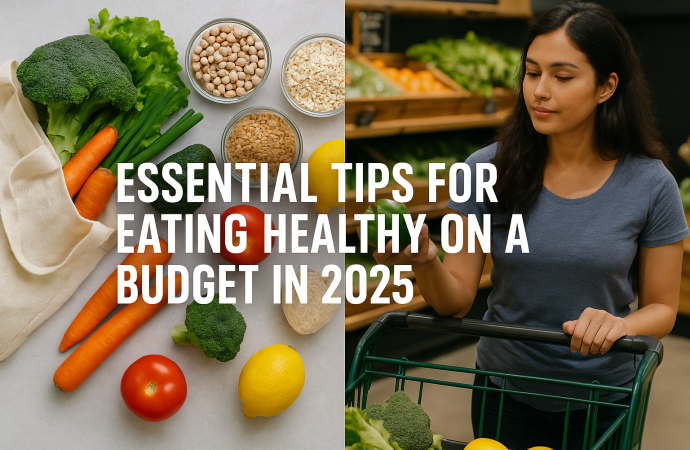Introduction Eating healthy doesn’t have to be expensive. In 2025, many people are looking for ways to eat nutritious meals while keeping their grocery bills under control. With rising food prices and the pressures of daily life, it may feel challenging to stick to a healthy eating plan without breaking the bank. However, eating well
Introduction
Eating healthy doesn’t have to be expensive. In 2025, many people are looking for ways to eat nutritious meals while keeping their grocery bills under control. With rising food prices and the pressures of daily life, it may feel challenging to stick to a healthy eating plan without breaking the bank. However, eating well on a budget is not only possible but also easy when you know the right strategies.
In this article, we’ll share essential tips for eating healthy on a budget in 2025. From meal planning and shopping smart to incorporating affordable, nutrient-dense foods into your diet, these tips will help you nourish your body without draining your wallet.
What is Healthy Eating on a Budget?

Image by: Yandex.com
Healthy eating on a budget refers to choosing foods that are both nutritious and affordable. It’s about making smart choices, like buying seasonal produce, planning meals in advance, and cooking at home rather than relying on expensive takeout. With a little effort and the right knowledge, you can prepare healthy, satisfying meals that fit your budget.
Many people think that eating healthy means spending a lot of money, but that’s simply not true. There are plenty of ways to incorporate affordable healthy foods into your diet without sacrificing flavor or nutrition. Whether you’re cooking for yourself or your family, healthy eating on a budget is all about being strategic and mindful of your food choices.
Essential Tips for Eating Healthy on a Budget in 2025

Image by: Yandex.com
1. Plan Your Meals in Advance
One of the most effective ways to eat healthy without overspending is by meal planning. By taking the time to plan your meals for the week, you can ensure that you’re buying only the ingredients you need, avoiding impulse buys, and reducing food waste. Meal planning also allows you to make sure that each meal is balanced, offering a mix of protein, vegetables, and whole grains.
Start by planning simple meals that use affordable ingredients. For example, meals like stir-fries, soups, and pasta dishes can be made using inexpensive ingredients like beans, lentils, and rice. Once you have a weekly plan, make a shopping list to help you stay on track.
Tip: Try using a meal prep strategy, where you cook meals in bulk and store them in the fridge or freezer for later in the week. This saves both time and money.
2. Shop Smart and Look for Discounts
Shopping smart is key to saving money while eating healthy. Start by taking advantage of sales, discounts, and coupons. Many grocery stores offer discounts on fresh produce and meats when they are in season. Additionally, buying in bulk or opting for store brands can help you save on staples like grains, beans, and pasta.
Don’t overlook the frozen aisle either. Frozen vegetables, fruits, and lean meats can be much cheaper than fresh items and are often just as nutritious. Frozen foods last longer and can be used in a variety of meals.
Tip: Shop at local farmer’s markets for fresh, in-season produce, which is often cheaper than supermarket prices. You can also check out discount grocery stores for even more savings.
3. Embrace Plant-Based Meals
Incorporating more plant-based meals into your diet is an excellent way to eat healthy on a budget. Vegetables, legumes, beans, and lentils are packed with nutrients and are much cheaper than meat. Beans and lentils are particularly affordable and can be used in a variety of dishes, such as soups, stews, salads, and even veggie burgers.
Plant-based meals are rich in fiber, vitamins, and minerals, helping to keep you feeling full and satisfied without the need for expensive cuts of meat. You don’t need to go fully vegetarian, but making plant-based meals a regular part of your routine is a great way to save money and eat healthy.
Tip: Make lentil soups or bean chili in large batches and store leftovers for future meals.
4. Focus on Nutrient-Dense, Affordable Foods
There are plenty of nutrient-dense foods that are also affordable. These foods provide a lot of nutrition for relatively low cost, allowing you to stretch your food budget while still getting the nutrients your body needs. Some of the best affordable nutrient-dense foods include:
- Eggs: A great source of protein and essential vitamins.
- Sweet potatoes: Rich in fiber, vitamin A, and potassium.
- Spinach and kale: Packed with iron, vitamins, and minerals, and often sold at affordable prices.
- Oats: An inexpensive whole grain that’s great for breakfast or baking.
Incorporating these foods into your meals will ensure that you’re eating well without spending too much.
Tip: Buy whole grains like oats, brown rice, and quinoa in bulk to save money. These grains are versatile and can be used in a variety of dishes.
5. Cook at Home Instead of Eating Out
Cooking at home is one of the most effective ways to eat healthy on a budget. When you eat out, you not only spend more money but also often end up with meals that are less healthy. Home-cooked meals are generally more nutritious because you control the ingredients and portion sizes.
To make cooking at home easier, try preparing meals in batches or using a slow cooker. This will save you time and money, and you’ll have healthy meals ready throughout the week.
Tip: Invest in a slow cooker or Instant Pot to make healthy, budget-friendly meals with minimal effort. These tools allow you to cook large quantities of food, saving both time and money.
6. Avoid Processed Foods
Processed and packaged foods are often more expensive and less nutritious than fresh, whole foods. While they may seem convenient, processed foods like pre-packaged snacks, frozen dinners, and sugary drinks can quickly add up and are often high in sodium, sugar, and unhealthy fats.
By focusing on whole foods and cooking from scratch, you can reduce your grocery bills and improve your diet. Stick to fresh produce, whole grains, and lean proteins, and limit the amount of packaged foods you purchase.
Tip: When shopping, try to focus on the outer aisles of the grocery store, where fresh produce, dairy, and meat are usually located. The inner aisles tend to be stocked with processed foods.
The Future of Budget-Friendly Nutrition

Image by: Yandex.com
The future of eating well on a budget looks bright. In 2025, more people are learning how to eat smart and save money. Schools and community centers are offering classes on cooking and meal planning. Grocery stores are starting to label affordable healthy items to make shopping easier. Apps can now help you track spending and find cheap, healthy recipes. There’s also a bigger push for food banks and local farms to offer fresh food to everyone. With more support and smart tools, healthy eating will become easier and more common for families everywhere no matter their income.
Comparative Table: Affordable, Nutrient-Dense Foods for Healthy Eating
| Food | Nutrients | Benefits |
|---|---|---|
| Eggs | Protein, vitamins B12 and D | Affordable source of protein |
| Sweet Potatoes | Fiber, vitamin A, potassium | Rich in antioxidants and energy |
| Spinach | Iron, calcium, vitamins K and A | Great for bone and heart health |
| Oats | Fiber, iron, B-vitamins | Supports digestive health |
| Lentils | Protein, fiber, folate | Inexpensive source of plant protein |
| Brown Rice | Fiber, B-vitamins, magnesium | High in energy and nutrients |
Conclusion
Eating healthy on a budget in 2025 is not only possible but also achievable with the right strategies. By planning your meals, shopping smart, and focusing on nutrient-dense foods, you can nourish your body without overspending. Embrace plant-based meals, cook at home, and avoid processed foods to save money while maintaining a balanced and healthy diet.
Remember, small changes in how you shop and prepare your meals can lead to big savings and better health. Take the time to make thoughtful food choices, and you’ll be on your way to a healthier, more budget-friendly lifestyle.
Call to Action
Ready to start eating healthy on a budget? Use these tips to plan your next grocery list and discover affordable, nutritious meals that will keep you feeling great all year. Visit our website for more budget-friendly recipes and meal planning ideas.
















